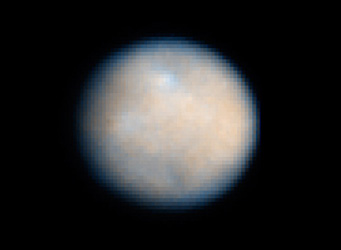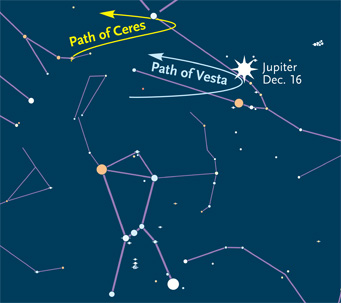Ceres, the biggest asteroid and brightest dwarf planet,shines at magnitude 6.9 or brighter from December 12-25.
Ceres has had a checkered career. It was acclaimed as a new planet when it was first discovered in the prominent gap between the orbits of Mars and Jupiter. It was demoted to an asteroid when many more objects were discovered with similar orbits. And most recently it has been promoted again to the status of "dwarf planet" — presumably to console Pluto when it was demoted to the same newfangled category.

The surface of Ceres, as revealed by the Hubble Space Telescope's Advanced Camera for Surveys, includes several brighter and darker regions that could be caused by impacts.
NASA, ESA, J. Parker (Southwest Research Institute), and others
The hallmark of a dwarf planet is that it's massive enough to pull itself into a sphere, which is certainly true of Ceres. I'm a little baffled why Ceres's smaller but brighter sibling Vesta doesn't qualify; it looks mighty round to me. Sure, it's not perfect, but does Everest disqualify Earth from being a planet?
Anyway, as things stand Ceres is by far the easiest dwarf planet to view, roughly 1,000 times brighter than Pluto, the second easiest. Even at its faintest Ceres is an easy target for small telescopes, and right now it's readily visible in small binoculars — and conceivably even without optical aid if you have really keen eyes and pristine skies.

Click on the image above for a full-page printable finder chart for Ceres and Vesta.
Tony Flanders
Ceres is at opposition to the Sun (180° away measured along the celestial equator) on December 18th, 2012, and it's brightest and closest to Earth on the 20th. It is then 1.6843 a.u.(252 million km or 157 million miles) distant and shines at magnitude 6.7.
Moreover, Ceres is splendidly placed in the sky. It's in Taurus, quite close to Vesta, also close to Jupiter, surrounded by bright stars and famous deep-sky objects, and nearly as high as it ever can get for observers at mid-northern latitudes. Click here for a printable, full-page finder chart for Ceres and Vesta.
Vesta and Ceres will continue to be bright and well placed for viewing in the evening sky through February and beyond.
The magnitudes of the asteroids for early 2013 are listed below.
| Date | Ceres | Vesta |
| January 1, 2013 | 7.1 | 6.9 |
| February 1, 2013 | 7.8 | 7.5 |
| March 1, 2013 | 8.3 | 7.9 |
| April 1, 2013 | 8.6 | 8.2 |
| May 1, 2013 | 8.8 | 8.4 |
.
Ceres is currently the most enigmatic large object within Saturn's orbit, but that will all change when the Dawn spacecraft starts to orbit it in February 2015. Dawn has yielded a wealth of new data on Vesta, and once Ceres has been studied in equal detail, we will perhaps be better placed to categorize the asteroids in general. Between them, Ceres and Vesta contain nearly half the mass of the main asteroid belt.
Few people are really happy with the IAU's dwarf-planet decision, and the term Plutoid, introduced at the same time, has blessedly fallen into oblivion. My colleague Alan MacRobert says that it sounds medical, as in "Doctor, doctor, my Plutoids are killing me."
NASA has recently taken to calling Vesta a protoplanet, a term that could apply equally well to Ceres. But that implies that they will eventually turn into planets, which isn't true. It's probably wisest to say that right now we don't know enough about medium-sized bodies in our own solar system and others to make genuinely meaningful categories.
 2
2









Comments
Jim Baughman
December 21, 2012 at 2:00 pm
I agree--jettison the whole lame classification structure that was created for the purpose of demoting Pluto from planet status. All the was really required was moving Pluto from a "planet" to a "KBO" (Kuiper Belt Object). All the other folderol about "dwarf planets" and "plutoids" etc. etc. were completely unnecessary.
Asteroids would remain "asteroids" as they have been since it was realized that Ceres isn't really a planet. If anyone felt it important to distinguish asteroids large enough to round themselves, the term "major asteroid" could perhaps be added.
You must be logged in to post a comment.
Stan Kerns
December 21, 2012 at 2:43 pm
Pluto is rapidly gathering moons, and when it has enough it will attack. And that will be the end for the Pluto deniers. Actually, Pluto is neither more nor less "different" from the gas giants than the terrestrial planets are--shall we kick them out too? Pluto is just "what happens" at that distance from the Sun--as is Mercury--Mars--Saturn--etc. By the way, is Triton a dwarf planet too?--probably what ever Pluto is it is. Brown's criteria "clear their orbit" isn't true for some rather accepted planets as well--what we have here is Brown seeking his Andy Warhol "Five minutes of fame"--and boy did he get it. Sad part is the guy has discovered really neat stuff and didn't need to mess with Pluto to be famous--it is about time he made amends.
Stan
You must be logged in to post a comment.
You must be logged in to post a comment.